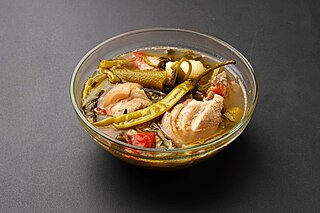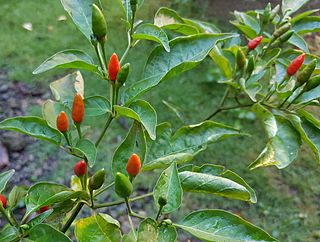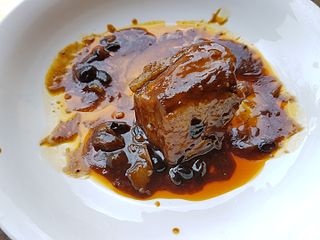
Fried rice is a dish of cooked rice that has been stir-fried in a wok or a frying pan and is usually mixed with other ingredients such as eggs, vegetables, seafood, or meat. It is often eaten by itself or as an accompaniment to another dish. Fried rice is a popular component of East Asian, Southeast Asian and certain South Asian cuisines, as well as a staple national dish of Indonesia. As a homemade dish, fried rice is typically made with ingredients left over from other dishes, leading to countless variations. Fried rice first developed during the Sui dynasty in China.

Adobo or adobar is the immersion of food in a stock composed variously of paprika, oregano, salt, garlic, and vinegar to preserve and enhance its flavor. The Portuguese variant is known as carne de vinha d'alhos. The practice, native to Iberia, was widely adopted in Latin America, as well as Spanish and Portuguese colonies in Africa and Asia.

Filipino cuisine is composed of the cuisines of more than a hundred distinct ethnolinguistic groups found throughout the Philippine archipelago. A majority of mainstream Filipino dishes that comprise Filipino cuisine are from the food traditions of various ethnolinguistic groups and tribes of the archipelago, including the Ilocano, Pangasinan, Kapampangan, Tagalog, Bicolano, Visayan, Chavacano, and Maranao ethnolinguistic groups. The dishes associated with these groups evolved over the centuries from a largely indigenous base shared with maritime Southeast Asia with varied influences from Chinese, Spanish, and American cuisines, in line with the major waves of influence that had enriched the cultures of the archipelago, and adapted using indigenous ingredients to meet local preferences.

Bistek, also known as bistek tagalog or karne frita, is a Filipino dish consisting of thinly-sliced beefsteak braised in soy sauce, calamansi juice, garlic, ground black pepper, and onions cut into rings. It is a common staple in the Tagalog and Western Visayan regions of the Philippines. It is eaten over white rice.

Sinigang is a Filipino soup or stew characterized by its sour and savory taste. It is most often associated with tamarind, although it can use other sour fruits and leaves as the souring agent such as unripe mangoes or rice vinegar. It is one of the more popular dishes in Filipino cuisine. This soup, like most Filipino dishes, is usually accompanied by rice.

The generic term for condiments in the Filipino cuisine is sawsawan. Unlike sauces in other Southeast Asian regions, most sawsawan are not prepared beforehand, but are assembled on the table according to the preferences of the diner.

Siling labuyo is a small chili pepper cultivar that developed in the Philippines after the Columbian Exchange. It belongs to the species Capsicum frutescens and is characterized by triangular fruits that grow pointing upwards. The fruits and leaves are used in traditional Philippine cuisine. The fruit is pungent, ranking at 80,000 to 100,000 heat units in the Scoville Scale.

Mang Tomas is a condiment brand owned by NutriAsia. Its core product is lechon sauce. The brand was developed by Hernan and Ismael Reyes in the late 1980s after they purchased the lechon sauce recipe of Aling Pitang lechon shop located in Quiapo, Manila. The Reyeses named their sauce "Mang Tomas Sarsa", after a popular lechon shop located in La Loma, Manila. In 1991, the brand was acquired by Southeast Asia Food, Inc.. The product is presently sold as "Mang Tomas All-Around Sarsa" in the Philippines and as "Mang Tomas All-Purpose Sauce" in export markets.

Philippine adobo is a popular Filipino dish and cooking process in Philippine cuisine. In its base form, meat, seafood, or vegetables are first browned in oil, and then marinated and simmered in vinegar, salt and/or soy sauce, and garlic. It has occasionally been considered the unofficial national dish in the Philippines.

Inihaw, also known as sinugba or inasal, are various types of grilled or spit-roasted barbecue dishes from the Philippines. They are usually made from pork or chicken and are served on bamboo skewers or in small cubes with a soy sauce and vinegar-based dip. The term can also refer to any meat or seafood dish cooked and served in a similar way. Inihaw are commonly sold as street food and are eaten with white rice or rice cooked in coconut leaves (pusô). Inihaw is also commonly referred to as Filipino barbecue or (informally) Pinoy BBQ.

Mama Sita's Holding Company, Inc. is a Philippine based manufacturer of condiments, selling its products under the brand, Mama Sita's. The brand is named after Teresita "Mama Sita" C. Reyes, matriarch of the company's founders, the spouses Bartolome B. Lapus and Clara C. Reyes-Lapus.

Stir-fried water spinach is a common Asian vegetable dish, known by various names in Asian languages. Water spinach is stir-fried with a variety of vegetables, spices, and sometimes meats. It is commonly found throughout East, South and Southeast Asia; from Sichuan and Cantonese cuisine in China, to Indonesian, Burmese, Cambodian, Filipino, Malaysian, Singaporean, Taiwanese, and Vietnamese cuisine; to Sri Lankan cuisine and Bengali cuisine in South Asia.

UFC is a Philippine food brand owned by NutriAsia. It was first introduced as a banana ketchup brand in 1969.

Humbà, also spelled hombà, is a Filipino braised pork dish from the Visayas, Philippines. It traditionally uses fatty cuts of pork belly slow-cooked until very tender in soy sauce, vinegar, black peppercorns, garlic, bay leaves, and fermented black beans (tausi) sweetened with muscovado sugar. It also commonly includes hard-boiled eggs and banana blossoms.

Pinatisan is a Filipino cooking process consisting of meat braised in patis, garlic, ginger, onion, black peppercorns, and bay leaves. Some recipes also add non-traditional ingredients like tomatoes, chili peppers, and other herbs and spices. Vinegar may also be added. It is very similar to binagoongan, which is made using fermented shrimp. It is also similar to Philippine adobo and paksiw, but is distinguished by the primary use of fish sauce in place of vinegar. Pinatisan has a strong umami flavor rather than the characteristic sour and sweet flavor of adobo.

Pastil is a Filipino dish made with steamed rice wrapped in banana leaves with dry shredded beef, chicken, or fish. It originates from the Maguindanao people and is a popular, cheap breakfast meal in Mindanao, especially among Muslim Filipinos.

Okoy or ukoy, are Filipino crispy deep-fried fritters made with glutinous rice batter, unshelled small shrimp, and various vegetables, including calabaza, sweet potato, cassava, mung bean sprouts, scallions and julienned carrots, onions, and green papaya. They are traditionally served with vinegar-based dipping sauces. They are eaten on their own or with white rice. They are popular for breakfast, snacks, or appetizers. Okoy are sometimes dyed bright orange with achuete seeds.

Ginataang labong or ginataang tambo is a Filipino vegetable stew made from bamboo shoots in coconut milk and spices with seafood or meat. It is the most common way of preparing bamboo shoots in Philippine cuisine. Ginataang ubod is a variant of the dish made with heart of palm but is otherwise prepared identically. It is a type of ginataan.

Silver Swan is a Filipino condiment brand owned by NutriAsia through its subsidiary First PGMC Enterprises, Inc. It was first introduced as a soy sauce brand in 1942 by Sy Bun Suan. Later on, the brand was expanded to include vinegar, fish sauce, chili sauce and oyster sauce.



















